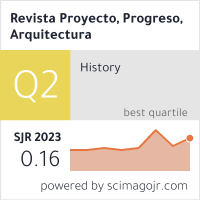LA COLECTIVIZACIÓN DE LA VIVIENDA EN EL SUBURBIO DE BAJA DENSIDAD. APROXIMACIONES A PROPÓSITO DEL PLAN TERRITORIAL METROPOLITANO DE BARCELONA / The collectivization of housing in the low density suburbs. Approaches regarding the regional metropolitan plan
DOI:
https://doi.org/10.12795/ppa.2011.i5.02Palabras clave:
suburbio, vivienda plurifamiliar, jardín, huerto, Plan Territorial Metropolitano de Barcelona, densidad, paisaje, territorio, suburb, multifamily housing, garden, allotment, Regional Metropolitan Plan of Barcelona, density, landscape, territory.Resumen
RESUMEN El crecimiento de los suburbios de baja densidad alrededor de las ciudades españolas durante la anterior década plantea un grave problema ambiental. No sólo es su crecimiento en extensión y la consiguiente reducción de áreas agrícolas o forestales lo que es preocupante, sino también la dependencia de sus habitantes del automóvil y la inviabilidad del transporte público. Para minimizar desplazamientos, el Plan Territorial Metropolitano de Barcelona propone inserir focos de densidad en el interior de estas áreas. Sin embargo, el Plan carece de propuestas arquitectónicas concretas; simplemente apunta hacia una dirección. Más allá del criterio ambiental, este artículo utiliza esta propuesta del Plan para reflexionar sobre qué sensibilidades debería respetar la vivienda colectiva suburbial, entendiendo que es desde el habitante y su modo de vivir como debemos empezar a abordar la “colectivización” del suburbio. La aproximación se efectúa mediante la revisión de ejemplos de edificios residenciales surgidos en distintos momentos arquitectónicos del siglo veinte, que resuelven de una u otra forma la relación de la vivienda con un espacio exterior privado, una relación de especial trascendencia para cualquier habitante suburbial. Estos modelos se agrupan en tres conjuntos: las viviendas obreras del primer tercio de siglo, los edificios escalonados generados durante el Movimiento Moderno y los diseños residenciales “inacabados” del tercer mundo. Después de observar los recursos utilizados en estos modelos concluimos con una serie de consideraciones inspiradas, a la vez, en otros ejemplos residenciales más recientes y orientadas a alumbrar el dilema entre densidad y suburbio en la actualidad.
SUMMARY The growth of low-density suburbs around Spanish cities during the past decade poses a serious environmental problem. Not only is it the growth in size and the consequent reduction in agricultural or forest areas that are of concern, but also the dependence of the inhabitants on the car and the inadequacy of public transport. To minimize commuting, the Regional Metropolitan Plan of Barcelona proposes to insert density pockets within these areas. However, the Plan has no specific architectural proposals, but simply points towards one direction. Beyond the environmental criteria, this article uses this proposal of the Plan to reflect on what sensitivities suburban collective housing should respect, understanding that it is with the inhabitant and their way of life in mind that we must begin to address the “collectivization” of the suburb. The approach is made by reviewing examples of residential architecture that emerged at different times of the twentieth century which resolved, one way or another, the relationship of the house with a private outdoor space, a relationship of particular importance for any suburban dweller. These models fall into three groups: workers’ housing in the first third of the century, the terraced buildings generated during the Modern Movement and the “unfinished” residential designs of the third world. After looking at the resources used in these models we conclude with a series of inspired considerations, while in other recent residential examples we attempt to illuminate the current dilemma between density and suburb.
Descargas
Citas
AA. VV.: Total housing: alternatives to urban sprawl. Barcelona: Editorial Actar, 2010.
Alberdi Jiménez, Rosario; Sáenz Guerra, Javier: Francisco Javier Sáenz de Oíza, arquitecto. Madrid: Editorial Pronaos, 1996.
Aldridge, H.: “La habitación Popular y la construcción Cívica”. En Civitas. Abril 1916, Nº 9. pp. 39.
Boesiger, Willy, Le Corbusier: Le Corbusier und Pierre Jeanneret. IHR Gesmetes Werk von 1929-1934. Zurich: Editorial Boesiger, 1935.
Bükle, von J. Christoph: Morger & Degelo architekten. Zurich: Editorial Verlag Niggli AG, 2000.
Busquets, Joan: Barcelona, la construcción urbanística de una capital compacta. Madrid: Editorial Mapfre, 1992.
Candilis, Georges: Arquitectura y urbanismo del turismo de masas. Barcelona: Editorial Gustavo Gili, 1973.
Carrera, Josep Maria: Pla Territorial Metropolità de Barcelona. Barcelona: Publicación Oficial de la Generalitat de Cataluña, 2008.
Carrillo Messa, Diego: Materiales Básicos para El Proyecto Integral del Hábitat. Propuestas para El Salvador, C.A. Barcelona: Editorial Fundació UPC, 2007.
Cerdà, Ildefonso: Tratado General de la Urbanización. Reforma y ensanche de Barcelona. Reedición, Madrid: Editorial del Instituto de Estudios Fiscales, 1968.
CIAM: CIAM. Internationale Kongresse für neues bauen. Dokumente 1928-1939. Basilea: Editorial Birkhäuser Verlag, 1979.
De Cauter, Lieven: The Capsular Civilization, On the City in the Age of Fear. Rotterdam: Editorial NAi Publishers, 2004.
Döker, Richard: Terrassen typ: Krankenhaus, Erholungsheim, Hotel, Bürohaus, Einfamilienhaus, Siedlungshaus, Miethaus und die Stadt. Stuttgart: Editorial Akademisher Verlag Dr. Fritz Vedekind & Co., 1929.
Druot, Frederic; Lacaton, Anne; Vassal, Jean-Philippe: Plus: La vivienda colectiva, territorios de excepción. Barcelona: Editorial Gustavo Gili, 2007.
Dunham-Jones, Ellen; Williamson, June: Retrofitting suburbia. Urban design solutions for redesigning suburbs. Hoboken (New Jersey): Editorial John Wiley & Sons, Inc., 2009.
GATEPAC: “Estudio de viviendas mínimas para Barcelona”. En AC, Documentos de Actividad Contemporánea. Enero 1934, Nº13. pp. 29-31.
Kolhaas, Rem: La ciudad genérica. Barcelona: Editorial Gustavo Gili, 2008.
Le Corbusier: La charte d’Athènes. París: Editorial Minuit, 1957.
Le Corbusier: La Ville Radieuse. París: Editorial Vincent, 1964.
Le Corbusier: Les trois établissements humains. París: Editorial Denoël, 1945.
Le Corbusier: Urbanisme. París: Editorial Arthaud, 1925.
Lustenberger, Kurt: Adolf Loos. Barcelona: Editiorial Gustavo Gili, 1998.
Majesty’s stationery office: Special report. Design construction and materials of various types of small dwelling houses in Scotland. Edinburgh. 1917.
Masjuan, Eduard: La ecología humana en el anarquismo ibérico. Urbanismo “orgánico” o ecológico, neomalthusionismo y naturismo social. Barcelona: Editorial Icaria, 2000.
Mc. Leod, Mary: Urbanism and Utopia: Le Corbusier from regional syndicalism to Vichy. New York: Columbia University Facsimile, 1985.
Minnaert, Jean-Baptiste: Henri Sauvage, ou l’exercice du renouvellement. París: Editorial Norma, 2002.
Molteni, Enrico: Álvaro Siza. Barrio de la Malagueira, Évora. Barcelona: Ediciones UPC, 1997.
Monteys, Xavier et al.: ReHabitar. Habitaciones satélite [2]. Madrid: Publicación del Ministerio de la Vivienda, Gobierno de España, 2010.
Mumford, Lewis: La carretera y la ciudad. Buenos Aires: Editorial Emecé, 1966.
Oyón, José Luís: La quiebra de la ciudad popular. Espacio urbano, inmigración y anarquismo en la Barcelona de entreguerras 1914-1936. Barcelona: Editorial Serbal, 2008.
Regni, Bruno; Sennato, Marina: Innocenzo Sabbatini: architetture tra tradizione e rinnovamento. Roma: Edición de la Galleria Arquitectura Arte Moderna, 1982.
Scalbert, Irénée: A right of diference: the archtecture of Jean Renaudie. París: Edición del Centre Pompidou, 2004.
SCCJ (Sociedad Cívica la Ciudad Jardín): “Grupo de casas baratas en Sevilla”. En Civitas. Abril 1915, Nº 5. pp. 146.
Schittich, Christian: High-density housing: concepts, planning, construction. Boston: Editorial Birkhäuser, 2004.
Sert, Josep Lluís: Can our cities survive? An ABC of urban problems, their analysis, their solutions; based on the proposals formulated by the C. I. A. M. Cambridge: Harvard University Press, 1942.
Soria Puig, Arturo: Cerdà. Las cinco bases de la Teoría General de la Urbanización. Madrid: Editorial Electa, 1996.
Soria, Arturo: Tratados de Urbanismo y sociedad. Madrid: Editorial Clan, 2004.
Stamm-Teske, Walter: Preis-werter Wohnungsbau 1990-96. Düsseldorf: Editorial Forum Zukunft Bauen, 1996.
Wilson, Edward O.: Sociobiology. The new synthesis. Cambridge MA: Editorial Belknap Press, 1975.
Descargas
Publicado
Cómo citar
Número
Sección
Licencia
Las ediciones impresa y electrónica de esta Revista son editadas por el Secretariado de Publicaciones de la Universidad de Sevilla, siendo necesario citar la procedencia en cualquier reproducción parcial o total.
Salvo indicación contraria, todos los contenidos de la edición electrónica se distribuyen bajo una licencia de uso y distribución “Creative Commons Atribución-NoComercial-SinDerivar 4.0 Internacional” ![]() . Puede consultar desde aquí la versión informativa y el texto legal de la licencia. Esta circunstancia ha de hacerse constar expresamente de esta forma cuando sea necesario.
. Puede consultar desde aquí la versión informativa y el texto legal de la licencia. Esta circunstancia ha de hacerse constar expresamente de esta forma cuando sea necesario.
Los autores/as que publiquen en esta revista aceptan las siguientes condiciones:
- Los autores/as conservan los derechos de autor y ceden a la revista el derecho de la primera publicación, con el trabajo registrado con la licencia de atribución de Creative Commons, que permite a terceros utilizar lo publicado siempre que mencionen la autoría del trabajo y a la primera publicación en esta revista.
- Los autores/as pueden realizar otros acuerdos contractuales independientes y adicionales para la distribución no exclusiva de la versión del artículo publicado en esta revista (p. ej., incluirlo en un repositorio institucional o publicarlo en un libro) siempre que indiquen claramente que el trabajo se publicó por primera vez en esta revista.
- Se permite y recomienda a los autores/as a publicar su trabajo en Internet (por ejemplo en páginas institucionales o personales) antes y durante el proceso de revisión y publicación, ya que puede conducir a intercambios productivos y a una mayor y más rápida difusión del trabajo publicado (vea The Effect of Open Access).









